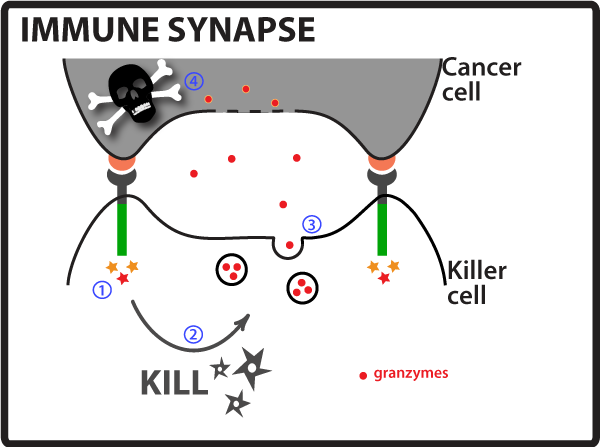Team:UCSF/Project
From 2010.igem.org
|
Project DescriptionThe UCSF 2010 iGEM team aims to combat one of the leading causes of death worldwide - cancer. Globally, cancer accounts for nearly 1 of every 8 deaths. The number is projected to rise continuously as 1,530,000 new cancer cases are expected to be diagnosed just this year alone. We attempt to fight cancer by enhancing the immune system’s functions using synthetic biology. Specifically, our goal is to turn natural immune cells into Synthetic Killers that can:
Introduction to Killer Immune CellsIn the mammalian immune system, many types of while blood cells with specific functions and responsibilities constantly work to defend the body against disease. There are two types of immune cells that are at the center of the fight against cancer: natural killer (NK) cells and cytotoxic T cells. NK cells are part of the innate immune response and survey the body for any unusual activity before signaling for additional help. If necessary, the activation of NK cells will then signal for a secondary response in which cytotoxic T cells are called to assist in the removal of the remaining unhealthy/cancerous cells. In this project, we will be referring to these cells as Killer Immune Cells. Both of these types of killer cells go through a similar process from detection to elimination of the cancer cell.
“Killer immune cells FIG” 2 - Immune Synapse Formation and Cytotoxic Granules Release Once a killer cell is activated and an immune synapse is formed, the cytotoxic granules present in killer cells get released to act on the cancer cell (Figure). These cytotoxic granules are rich in killing agents, such as granzymes, and once these agents penetrate the cancer cell membrane they will induce the cancer cell to apoptose (kill itself). The immune synapse, a tight embrace between the cancer and killer cell, limits the spread of the killer cell’s arsenal to neighboring, possibly healthy, cells.
Project Aims: Our goals and motivationsTo eliminate cancer more efficiently we thought we could use synthetic biology to engineer synthetic cancer killers that would have improved detection, activation and killing arsenal. For that we would have to modify different steps on the pathway from cancer detection to elimination. Our SYNTHETIC CANCER KILLERS would have:
To learn how we approach these different challenges continue reading on our subprojects webpages. Overall projectYour abstract
Project DetailsPart 2part2The ExperimentsPart 3Results
|
RIGHT CONTENT
replace this area with your content. |
 "
"

